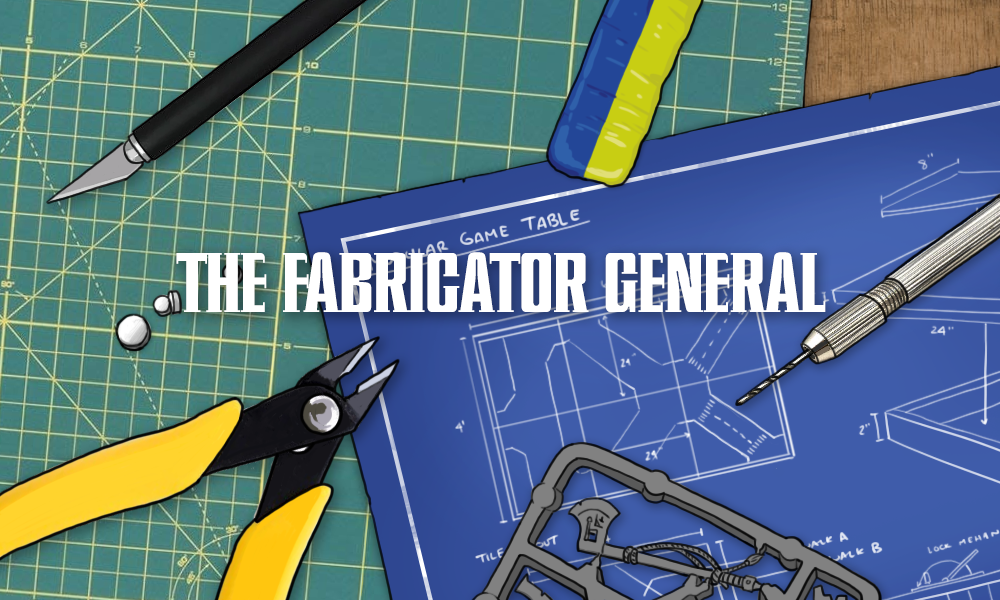Though it was one of the best games that GW ever put out, Battlefleet: Gothic is long out of print. While you can still find miniatures for it available on eBay and other second-hand sites, these miniatures tend to go at a fairly steep price (as of today there’s a box of two unassembled Imperial Cruisers on eBay for $70). Worse, because BFG gives you the option of fielding so many different ship classes, it can be daunting to drop that kind of cash knowing that by choosing to model any given ship type that you’ll be locking yourself out of representing most of the others.
But fear not, for there is a solution to this problem: MAGNETIZE EVERYTHING!!!
This article is a step-by step instruction for how to turn your precious Imperial Cruiser hulls into blank slates whose configuration can be changed in mere moments, allowing you to field virtually any class of cruiser you want. So, grab your clippers, hobby knife, and pin vise and let’s get started!
Step 1: Materials
For this project, you will need the following:
- Plastic cement
- Superglue
- A hobby knife
- A pin vise with a 1/16” bit
- A toothpick
- A ruler
- A steel weedge
- Loads of 1/16” x 1/32” disc magnets
- Patience
“OK, but what the hell is a ‘weedge?’” I hear you ask. “Weedge” is a colloquialism for any non-specific tool or object that can be pressed into service to do a specific job. In our case, all we’re looking for is an object that is made of ferrous metal to which a magnet will stick, preferably one that has at least one flat surface that is bigger than 1/16” in diameter but not so large as to make it unwieldy. This will allow us to stick a magnet to the weedge and use the weedge to push it into place, making sure the magnet is pushed in sufficiently far to be flush with the surface, but not so far that it’s indented. In my case, I have a steel half-round file with a handle that’s about 1/8” in diameter and flat on the end that makes it the perfect weedge for this sort of thing.
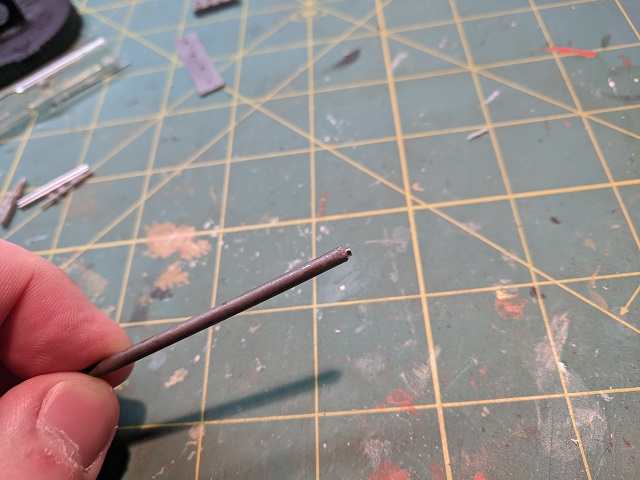
Also, I’m pretty specific about my magnet recommendation, and there’s an important reason for that. First, some of the pieces we’ll be drilling into are fairly small. As such, you’re going to want small magnets. Second, drilling makes for round holes so round magnets are easy to fit into the resulting hole without doing any kind of surgery. Finally, some of the bits we’ll be drilling into are fairly shallow, so we don’t necessarily have the space to be making deep holes. Combining all these factors together, 1/16” x 1/32” discs are the perfect size for pretty much all the places we’re going to want to put them. They’re also dirt cheap – you can get a pack of 200 of them for less than $12 at Amazon or even Home Depot.
Step 2: Hull Assembly
Some of the holes we’re going to drill – those for the dorsal and prow weapons – are going to be along the centerline if the ship. This is going to be right along the seam between the two halves, and because of this, you’ll need to assemble the main body of the cruiser first.
That said, the “wings” on each cruiser have fiddly antennae on them that are just going to get in the way of some of the drilling and dry-fitting we’re going to be doing later, so I suggest that you leave the wings and engines off until all the drilling and gluing of magnets is done. I did attach the bridge piece to mine just to give me a little something extra to hold onto, and it’s a pretty sturdy chunk of plastic so I didn’t have to worry about bending or breaking it.
Once you’ve given your plastic cement enough time to fully set, you’re ready to start drilling some holes.
Step 3: Broadside Armament
Imperial cruisers are designed to have two slots for weapons bays on each side of the ship. Each cruiser sprue comes with a weapon sprue that contains two each of weapons batteries, lance batteries, and launch bays. Ordinarily, you’d pick whichever two you wanted, glue them on, and call it a day. The class of ship you were fielding was based on which combination of weapons were mounted on the ship. For instance, the Tyrant class cruiser had one lance battery and one weapons battery on each side. But we’re going to magnetize everything such that we can swap weapon bays in and out quickly and easily and field whatever class of cruiser we want.
Making a Jig
The mounting area for the broadside weapon bays is roughly 9mm tall and 37mm long. This is like a hair over 11/32” of an inch tall and a hair under 1.5” long. Frankly, it’s a size that defies easy measurement. But no matter, we can get “close enough” for our purposes. What we want to do is drill four holes in this area that are centered vertically and evenly spaced such that the gap between the holes of any one plate and the gap between plates is the same. You could lay it out differently – and so long as you’re consistent it largely doesn’t matter – but spacing things out evenly means you’re minimizing magnet-to-magnet interactions along the length of the ship. It also lets you take advantage of markings on the weapons bays themselves when it comes time to magnetize those pieces.
In order to set my spacing and keep it consistent, I actually made a jig. This was just a flat plate of thin plastic (scrap from my bits box) cut to fit perfectly into the mounting area. Once I had this piece cut to size, I used a ruler to mark out the locations for my holes, measuring from one end at roughly 3/16”, 17/32”, 29/32”, and 1 ¼”. If your ruler is like mine it only has 1/16” markings, but fortunately we’re using a 1/16” drill bit in our pin vise so it’s an easy matter of judging whether the bit is centered on a line or between two lines. Once I have the locations marked, I drill the holes. Now that we have a reference jig plate, we’re ready to start drilling holes in the miniature itself.
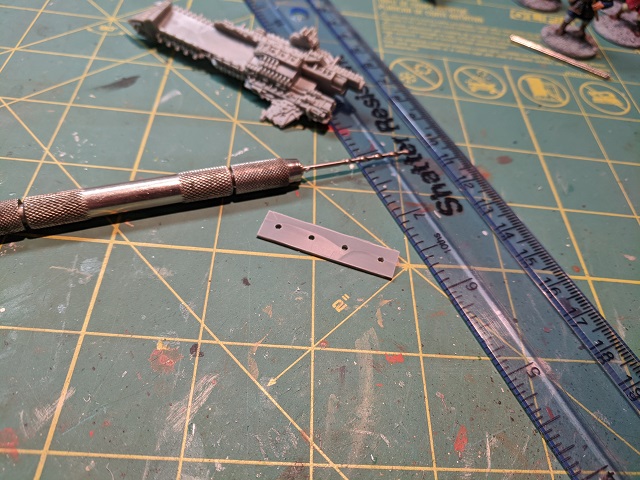
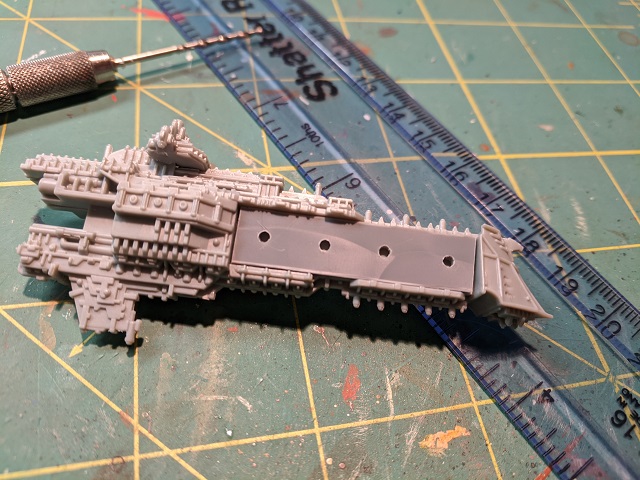
Drilling the Holes
As an aside, I DO NOT recommend using a Dremel or other powered drill to do this work. Even at their lowest settings, powered drills turn at an incredibly high RPM, and even the slightest slip has the potential to cause major damage. Similarly, the high rate of turn also causes heat to build up quickly, and when we’re talking about tiny plastic parts that can result in warping that can wreck things. You’re much better off taking the slow and steady approach and drilling your holes by hand using a pin vise. Everything we’re drilling into is relatively soft plastic, so a Dremel is overkill.
And this part is easy – just pop the jig plate into the mounting area, put the bit of your pin vise through the hole in your jig, and give it a couple of turns. You’re looking for just enough to make a little dimple in the plastic of the miniature. Then you can remove the jig plate and make sure your dimples look nice and evenly spaced. If they do, you can go ahead and finish drilling the holes.
There are a few caveats here: first, it’s important to be gentle. When using a pin vise you don’t want to apply too much pressure lest you bend or break the plastic of the mini. If you have a sharp bit, it doesn’t take much pressure to make this work. Second, you want to make sure that your bit is as perpendicular to the surface of the mounting area as possible, as you want your magnet to be flush and not tilted. This is less important here than it is with the dorsal weapons, but it’s always good practice to make sure you’re not angled either vertically or horizontally when drilling your holes. Finally, once you’re through the plastic of one side of the ship you may be tempted to just keep going and drill through the other side as well – fight this temptation! It’s really hard to keep your bit perpendicular this way and you’re likely to punch through the other side somewhere other than where you wanted. You’re much better off drilling all four holes on one side, then turning the ship over and using your jig plate on the other side to mark and drill those holes as well.
Mounting the Magnets
Once all the drilling is done, it’s time to mount the magnets. If you’ve worked with magnets before, you know all of the caveats here – you need to be super careful about the alignment because you want your parts to stick to the miniature, not be repelled from it. Some people go to the extreme of going through their stack of magnets with a sharpie and marking the “north” pole on every one to avoid mishaps. I find that’s a pain with these teeny tiny magnets, so I just check and double-check everything before I glue something. But the key to everything is to be consistent; the first magnet you glue is going to dictate the direction of every other magnet you mount – not just on this cruiser hull but on all the rest of them as well. This will be referred to as your “broadside reference magnet.”
Once you’re ready to mount your first magnet, stick it to the end of your metal weedge. Now, apply a little bit of superglue to the end of a toothpick and use the toothpick to apply the glue to the inside rim of the hole. With magnets this small, if you try to apply glue to the magnet itself all you’re likely to do is end up gluing your magnet to your weedge. Not helpful. It doesn’t take much glue, as if you’ve been careful about drilling your hole the magnet will fit pretty snugly. Once you’ve applied a little glue to the inside rim of the hole, use your weedge to push the magnet in all the way until its surface is flush with the surface of the mini. This is why it’s important for your weedge to be bigger than the magnet itself, as otherwise you’re likely to end up counter-sinking your magnet. Also not helpful. Just in case some glue got on it, you’ll want to give your weedge a spin or a wiggle side-to-side, making sure its flat face stays flush to the miniature. Give the glue a few seconds to cure, then carefully slide your weedge to the side until it breaks contact with the magnet. Don’t just pull straight away from the miniature, lest you pull the magnet out as well. But if you’re careful – voila! Your reference magnet is mounted!
Now you just have to do this seven more times, but for the remaining magnets there’s one very important step – when you hook the magnet to your weedge, you need to check it against the reference magnet to make sure it’s aligned in the same direction. What I find is easiest is to actually stick the next magnet to my reference magnet, then stick the edge of my weedge to it, then gently push both magnet and weedge to the side until contact with the reference magnet is broken – now I have the magnet where I want it and I know it’s oriented the right way. Easy!

It’s important to note that you’re mounting ALL of the broadside magnets here in the same direction as your reference magnet, even the ones on the other side of the ship. That means that the same pole is always facing “out” for all 8 magnets you’re sinking into the broadside mounts.
As an aside, you certainly could use a bigger, more powerful magnet here and drill fewer holes, but then you run into an important limitation: the internal width of the center mount plane for the broadside weapons is about 5/32” from one face to the opposite. If you used a larger magnet – something like a 1/8” round – you could maybe mount one into each side of the hull and still have them be flush with the mounting surface on both sides. But if you did so, you’d only have a gap of about 1/32” between them. 1/8” rare earth discs are fairly powerful magnets and keeping two of them apart (if they’re lined up the same direction) or together (if they’re oppositely aligned) with such a small gap in between is going to be a tall order. Going with co-polar alignment you could get around this by putting a spacer between them, but then you have another problem – if your magnets are aligned with their poles in the same direction, then the magnets you set into the various weapon bays are different for opposite sides of your ship. This means you have an explicit “port” and “starboard” version of each weapon. By going with the smaller magnets, we can avoid this problem entirely, and any weapon bay will fit into any slot.
Step 4: Weapons Bays
Right, so now you have the broadside mounting areas of your hull fully magnetized, and it’s time to magnetize the weapons bays themselves. There are three different types, and each one needs a slightly different treatment.
Lance Batteries
Lance batteries are probably the easiest, because the back part of the bay is flat. All you need to do is measure about 5/32” in from each end and mark a spot where you cross the vertical centerline. Drill a hole at each of these locations. From here, the easiest way to mount magnets into the face is to stick two magnets to adjacent magnets on one side of your hull, use a toothpick to get a little dab of glue in the two holes on your lance battery plate, and push the plate onto the hull such that the magnets slide into the holes. You might need to jiggle things around a little bit to get both magnets in, but this has the benefit of guaranteeing that they’re properly aligned. Once the magnets are in, give the whole plate a little jiggle side-to-side to keep any excess superglue from fusing the lance battery to the hull – we’re trying to make this modular, after all! After you’ve given the glue in the holes a few seconds to set, carefully slide the lance battery sideways until the magnets break contact. Now you should be able to pull it off and inspect the back to make sure the magnets are fixed and flush. Congratulations, you’ve done your first dorsal weapon!
Weapons Batteries
Unlike the lance battery plate, the back side of the weapons battery plate isn’t flat. Rather, it is both indented and angled slightly, which is a little bit of a pain in the ass. The up-side, however, is that there are indentations along the top and bottom edges that you can use as a guide for drilling your holes (you’ll want to sink a hole along the vertical center point between the each of the first and third pair of indentations). Because the back of the bay is indented, your holes don’t need to be very deep. In fact, just after the bit is fully engaged (meaning that you’re past the conical part at the end of the bit and the hole is at its full diameter) you’ll want to stop. No lie, it should be fairly shallow, no more than half the width of the magnet or so. Also, you’ll want to be careful about the angle you’re drilling, as you want to be perpendicular not to the angled plastic surface, but rather to the “mount plane.” This can be a little tricky, so you’ll need to be gentle and patient.
Unfortunately, because of this angled and indented back it’s hard to do the “stick the magnets to the hull and the weapon to the magnets” trick we used for the lance batteries. Instead, you’ll likely have to mount the magnets individually, which you can do with your weedge just like you did for the magnets in the hull – with one IMPORTANT difference: the magnets need to be going in the opposite direction to your broadside reference magnet. Stick a magnet to your weedge and check it against the reference magnet in the hull; if it attracts, it’s wrong and you need to flip it over. If it fights you or tries to squirt away, you’re good. Using your toothpick, run a little glue into the hole in the battery, then use your weedge to gently push the magnet into the hole, only this time you’re not trying to make it flush with the inside (angled) surface, you’re trying to make it flush to the mount plane. Give the glue a few seconds to cure and slide your weedge off until it disengages from the magnet. These little magnets are strong and the hole is shallow, so you may need to use your fingernail or a flat toothpick to hold the magnet in place when removing your weedge.

Pro-tip: if you ever have a magnet pop out of its hole on you when you try to separate your weedge from it, MAKE SURE you always check it against your reference magnet before you try to stick it back in. Remember, the magnets that go into the broadside weapons need to be opposite to the reference magnet, because when you push them into the back of the weapon you’re essentially flipping them over.
Launch Bays
Like the weapons batteries, the launch bays have hollow backs – really hollow backs! There’s nothing to mount a magnet to at all! Fortunately, you have oodles and oodles of sprue material that makes a perfect filler. Just cut a chunk of the right length from the sprue that held the broadside armaments. Cut it a little longer than you need and file or shave it to fit, as nothing is worse than hacking out a chunk and discovering that it’s too short. Once you’re satisfied that it’s the right size, run a thin bead of plastic cement down the middle of the inside of the launch bay – there’s like a little bar between the upper and lower openings – as well as a dab on each end of your sprue bit. Now stick the sprue bit in with the narrow side down and situate it such that the sprue is vertically centered in the gap and its back face is flat. Give it some time to cure.

Once everything is glued in and solid, you’re going to drill two holes just like you did for the weapons battery – use the top and bottom indentations as a guide and drill shallow holes. Fortunately, if you did it right your sprue bit’s back is at the same angle as the “mount plane,” so you can just drill a hole that’s about half a magnet-width deep and mount magnets in the holes just like you did with the weapons battery. Easy!
One note on launch bays – unlike the other broadside weapons launch bays are directional, meaning they have a “bow” and “stern” orientation. By mounting the magnets in the hull and the launch bay itself the way we have, you can always orient your launch bays the “correct” way just by rotating them when you slot them in for a game (because they’re identical on the top and bottom). That way, any launch bay can fit in the correct orientation in any slot regardless of which side of the ship it’s on. Brilliant!
Step 5: Dorsal Armament
The thing that distinguishes Imperial cruisers from battlecruisers is usually the presence of dorsal weapons. Every BFG Imperial cruiser model comes with two little holes along the top of the centerline of the ship that are for mounting either masts or turrets. We can apply the same technique we used for the broadside weapons to the dorsal mounts – but this time we only have to drill two holes instead of eight, and we have “pilot holes” already made for us! So, take your handy pin vise and expand the holes in the top of the hull. You’ll want to pay special attention to making sure you’re not drilling on an angle here, as we want the magnet to be mounted as close to perfectly flush as possible. The reason for this will become apparent shortly.
Once your hole is drilled, repeat the magnet mounting process; use a toothpick to run a little glue along the inside edge of the hole and use your weedge to push the magnet into the hole until it’s flush with the external surface. The first one you do is going to be your dorsal reference magnet, and we’re going to use it to do all of the other mounts. The orientation of your dorsal reference magnet doesn’t have to be the same as your broadside reference magnet, but it never hurts to get in the habit of being consistent.

Dorsal Weapons
Now that your dorsal reference magnet is in place, clip a tiny turret off one of your weapons sprues. These are ostensibly for your lance batteries (and the sprue only includes 4 turrets, just enough to do both lance batteries and no more, but we’ll revisit this later). On the bottom of the turret is a little peg that would have fit in the original dorsal mount holes – carefully cut this off with your hobby knife so the bottom is flat. Now use your pin vise to drill a hole in the bottom of the turret, making sure the hole is deep enough that the magnet can be pushed all the way in and sit flush to the bottom of the turret.
The next step is easy: just take one of your magnets and plop it on top your dorsal reference magnet, run some glue inside the hole in your tiny turret using a toothpick, and push the turret onto the protruding magnet. Simple! Make sure no excess glue squishes out, but if it does you can keep it from setting by rotating the little turret. Give the glue a few seconds to set, then disengage your magnets by sliding the turret along the surface the same way you disengaged your weedge when setting the broadside magnets.
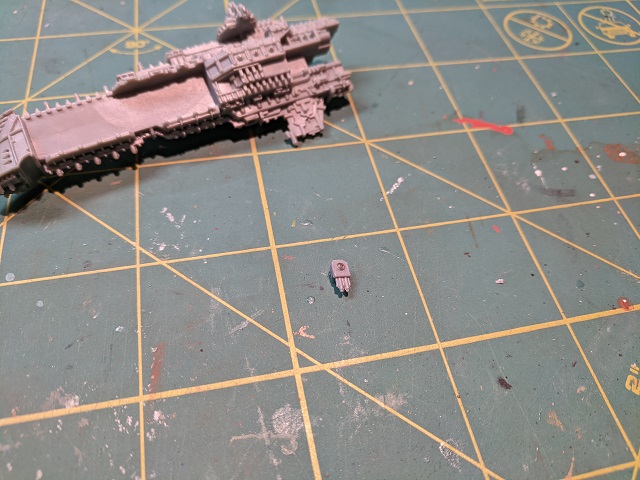
You can now reverse this process to set the other dorsal mount magnet – stick the magnet you want to place in the hull to the magnet on the bottom of the turret and use the turret to push it into the hull. This is quick and easy and guarantees that all of your magnets are properly aligned.
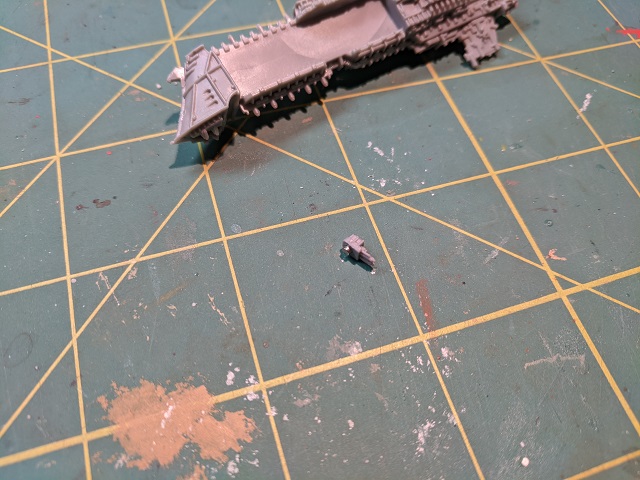
Dorsal Masts
But say you’re not fielding a battlecruiser for a particular battle – what then? Well, you could just leave the turrets off and that dorsal spot empty. Or you could magnetize the tiny masts that come with the kit!
This turns out to be incredibly easy. The bottom end of each mast has a narrow part that is meant to be inserted into the original dorsal hole. Carefully cut this part off, taking care to make sure you’re not trimming it off at an angle. Give it a quick pass with a flat file if you do accidentally make an angled cut. Then, just take one of your tiny magnets, stick it to a dorsal mount magnet, use a toothpick to put a tiny dot of glue on top of it, and stick your mast to it. The masts are just a hair smaller than 1/16” in diameter, so they fit perfectly on top the magnet. Make sure the mast is straight as the glue is setting.
And this is why you want your dorsal mounting magnets to be as flat and flush to the top surface of the hull as possible: if they’re not, your masts will be angled and weird looking. But with a little bit of patience, you can make your cruiser models more visually interesting.
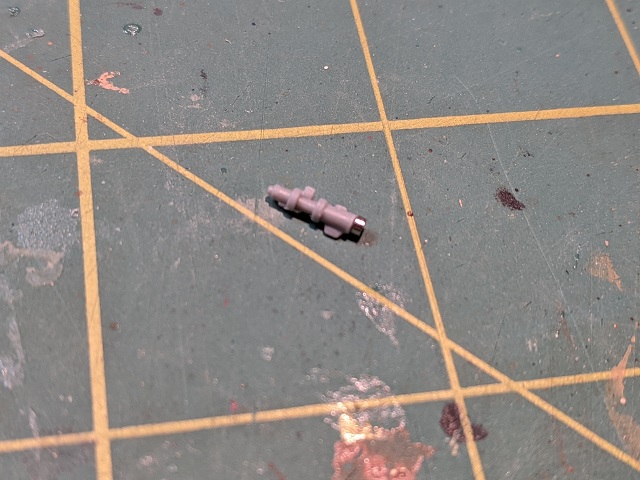
Lance Batteries
Because the cruiser kit only gives you four tiny turrets and you need all of them to outfit both lance batteries supplied with the kit, magnetizing some of them for dorsal weapons means you can’t use them for the lance battery – unless you magnetize one of your lance batteries! This is easy to do, just drill sufficiently deep holes where the turrets would sit on the lance battery plate (and again, we fortunately have “pilot holes” with which to work here), repeat the process you went through to place your second dorsal magnet, and congratulate yourself on your cleverness.

Battlecruisers are less commonly fielded than basic cruisers, so I wouldn’t go nuts on magnetizing too many lance turrets. One pair for every two cruiser hulls is probably sufficient, the rest can be glued as normal. I just mention it here because having sufficient turrets to do lances is a perpetual problem for Imperial players, purely because the kit comes with exactly enough and no spares.
Step 6: Prow Armament
Technically speaking, Imperial cruisers with torpedo tubes do not have Nova Cannon and vice versa. “Not enough room in the forward bulkhead for both armaments,” or perhaps some long-forgotten Imperial edict, whatever. If you’re going the extra mile of filling the prow torpedo tubes of your ship with putty to reflect this difference, you can just glue on a Nova Cannon or ram as appropriate and be done with it.
But we’ve come this far, why stop now?
You can magnetize the prow undermount pretty easily as well, giving you the choice between whether or not to field a Nova Cannon on every ship you put on the table. This process works exactly the same way, with one important caveat: for the prow undermount, we’re going to be drilling two holes pretty close together. That means the magnets are going to sit almost side-by-side, and for anyone familiar with magnets that means that they need to be in opposite orientations from each other.
On the underside of the prow there’s a slot for the prow armament. Beside this slot there are a couple of little points that stick up on either side. These index with a little nub on the Nova Cannon to keep it in position in the forwards/backwards direction, and in the middle of the track right along that index channel was the spot I found easiest to place my first magnet. Drill a hole here. Then, drill a hole just forward of it, such that the edges of the two holes are separated by maybe half the width of one of your tiny magnets.
Once both holes are drilled to your satisfaction, it’s time to glue in a magnet using the same process as all the previous ones. Just beware that this is a tight fit in a narrow slot, so you might need to find an alternative weedge if the one you’ve been using so far doesn’t fit. Just like before, the very first magnet you set is going to be your reference magnet for all future prow weaponry. Once the first magnet is in, set the second one with the opposite pole facing out. You can check this by putting it on the end of your weedge and trying to stick it to the magnet you just placed – if it attracts, it’s wrong and you need to flip it over. If it fights you, it’s correct. Once you have it aligned properly, go ahead and glue it in place.
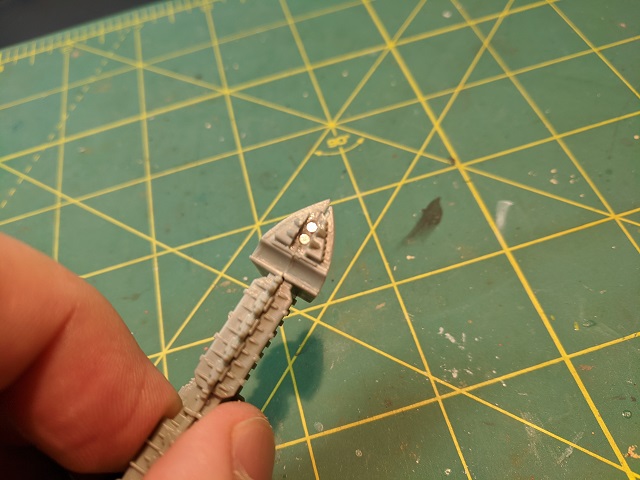
Now you’re going to reverse the process on the prow weaponry. You can save yourself some time and heartache here (especially with the ram, which allows for more jiggle space) by using the same method you used for the dorsal turrets: attach a magnet to each of the prow mount magnets, put a tiny drop of glue on top each with a toothpick, and push the ram onto them until it’s flush.
Or you can do it the old-fashioned way by checking the orientation of every magnet you’re going to put into each prow weapon, making sure that on your weedge it’s oriented to repel the hull magnet it will mirror before gluing it into the weapon.
When drilling holes in the Nova Cannon or ram, just be aware that these pieces are pretty tiny and there’s very little margin for error. Go slow, be patient, and try to keep your holes as perfectly centered as you can.
Step 7: Other Cruisers
If you plan to give your other cruisers this same treatment (and why wouldn’t you, it’s awesome), then it’s important to make sure you are consistent in the polarity of the magnets between all of your other cruiser hulls. Fortunately, once your holes are drilled you can use a lance battery plate (broadside mount), dorsal turret (dorsal mount), or ram prow (prow mount) to set your magnets, taking care to make sure they’re flush. By doing this, you ensure that any weapon can be mounted to any cruiser hull, which is entirely the point in doing all this in the first place. It guarantees maximum flexibility and lets you field pretty much any combination of cruisers or battlecruisers you like so long as you have enough bays to go around.
Step 8: Final Assembly
Once you’ve magnetized the various parts of the hull to your satisfaction, it’s time to complete the assembly. Glue on the wings and engines as normal and everything is ready to prime and paint!
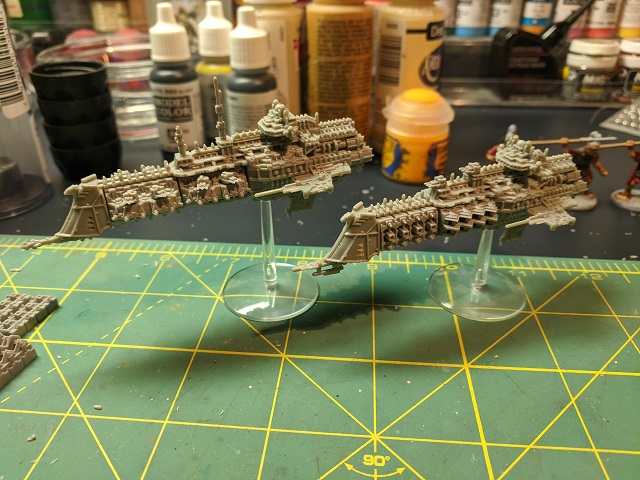
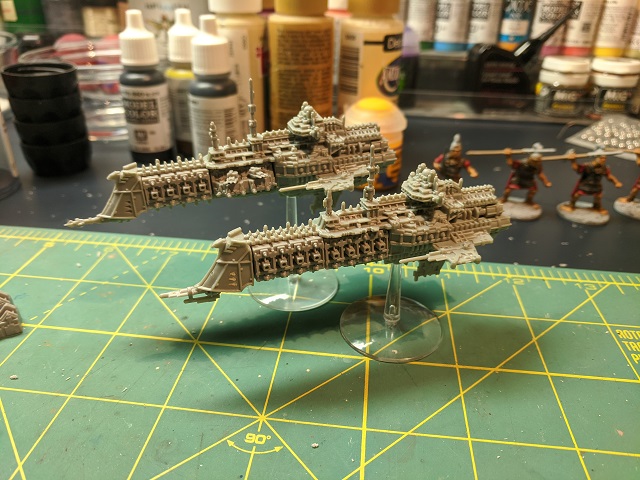
A minor note on painting – there are certain paints that have ferric components in their pigments that will behave…strangely in the presence of magnets. These tend to be brown or rust colored pigments (go figure) but a) these are not commonly used for BFG ships anyway, and b) most of the places where the magnets are located aren’t going to be visible once the weapons are in place. But if for whatever reason you’re planning to use Vallejo US Field Drab on your cruiser, just know that you’ll likely need to do a couple of touch-ups in the vicinity of your magnets.
Step 9: Storage
Now that you have lots of detachable fiddly bits for your Imperial cruisers, you’re going to want to store them in a way that is easy and secure and keeps them from getting lost. I’ve found one of the best storage containers for all these little magnetized bits is a metal mint tin (think like an old Altoids box). They close securely and are made of ferrous metal so the magnets will stick to them (so even if it does pop open in transport, the bits are likely to stay put). They’re also ace for torpedo, ordnance, and blast markers!
Ready to Deploy!
It’s worth noting that everything described here for plastic Imperial Cruisers also applies to 3D-printed models as well. Whether plastic or resin, there’s no reason you couldn’t use the same techniques on a 3rd party printed mini, which are available from a couple of different suppliers now that Battlefleet: Gothic is out of print.
Magnetizing all these parts takes a little time and patience, but no more so than anything else in the hobby. And the first time you drop a weapons battery into one of your cruiser hull’s broadside slots and hear that satisfying “click” as it snaps into place, you can take satisfaction in a job well done. Now get out there and give those wretched Eldar Corsairs a volley!
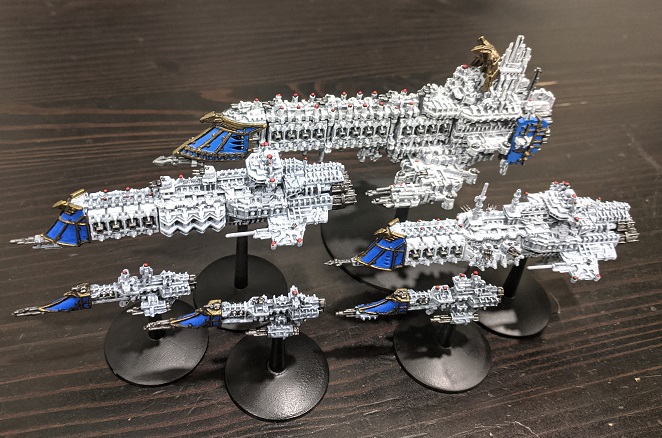
Have any questions or feedback? Want to share your own lovingly painted fleets? Drop us a note in the comments below or email us at contact@goonhammer.com.
